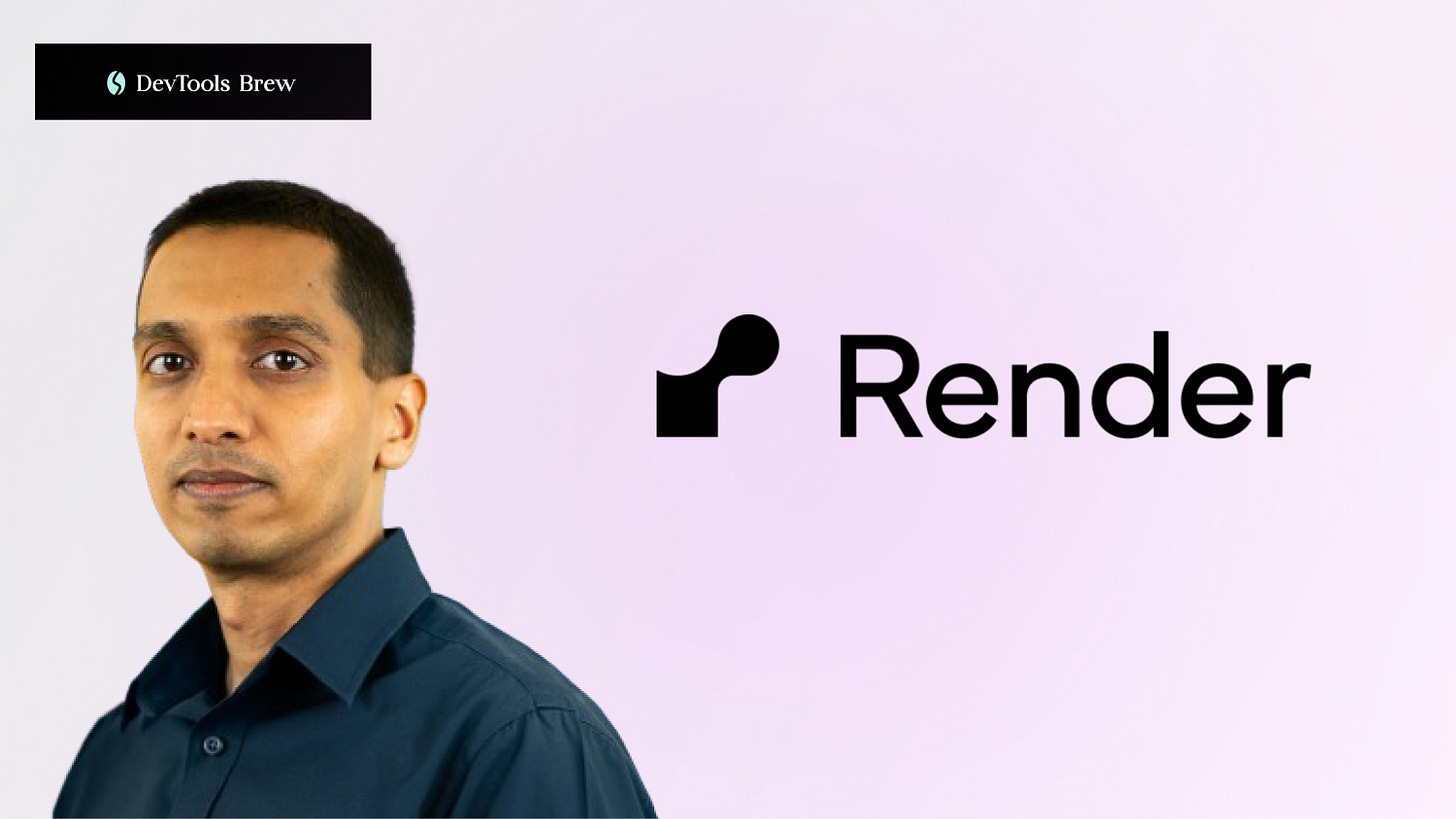DevTools Brew #59: Render Story: Redefining Cloud Hosting for Developers , 5 Metrics Series A Investors Look For At Dev-tools Startups...
Hey folks, welcome to DevTools Brew Newsletter #59!
If you're new here, my name is Morgan Perry, co-founder of Qovery.
Every Saturday, I share the stories, strategies, and insights behind the most successful devtool companies. Subscribe to receive weekly stories :)
Also, follow me on Linkedin if you don’t already!
In this Issue #59:
📈 Render Story: Redefining Cloud Hosting for Developers
📕 5 Metrics Series A Investors Look For At Dev-tools Startups
⭐ Star History Weekly Pick
Let's dive in!
📈 Render Story: Redefining Cloud Hosting for Developers
Render has developed significantly since its inception. As of now, Render has raised $82+ million through various funding rounds, including the latest $50 million Series B round. The platform currently handles 80+ million requests each week, indicating significant usage and reliance by its users.
Today, it's a short but interesting deep dive into the Render’s journey (and its founder, Anurag Goel), the cloud platform that simplifies the hosting process for developers and startups👇
Key Takeaways:
Background and Render’s Origins
From Stripe to Startup: Before founding Render, Anurag served as the Head of Risk at Stripe, where he played a pivotal role in scaling the company to a $5B valuation. His entrepreneurial spirit was further honed through the founding of Crestle, an AI infrastructure venture that was later acquired, demonstrating his knack for identifying and filling technological gaps in various sectors.
Solving Personal Pain Points: The inception of Render was driven by Anurag's own frustrations with existing cloud solutions. Traditional platforms either lacked simplicity or were not scalable without significant cost. Render was born from the desire to eliminate these pain points for others in the developer community.
Embracing Ambitious Projects: Anurag initially hesitated to launch Render, viewing the project as too daunting. However, his successful experience building and scaling companies provided him with the confidence to eventually pursue the idea, underscoring the importance of timing and preparedness in entrepreneurship.
The Early Days
Prototype to Platform: Render started as a modest serverless environment tailored for Python but quickly evolved. Anurag realized that to support a broader range of applications, Render needed to transcend its initial model to avoid vendor lock-in scenarios reminiscent of services like AWS Lambda.
Community and Feedback: The initial development and iterative improvements at Render were heavily influenced by feedback from the technical community around South Park Commons. This engagement provided invaluable insights that helped refine Render’s offerings.
Expanding the Vision: The strategic move to a more inclusive platform led to the development of a robust service capable of hosting web applications across various languages and frameworks, integrating seamlessly with continuous deployment tools like GitHub.
Business Model and Expansion
Strategic Pricing: Anurag introduced a freemium model at Render, which has been crucial for onboarding users. The platform offers free services for static sites and scales up to paid plans that provide more resources as needed. This model has helped Render attract a wide user base, from individual developers to growing startups.
Leveraging Word of Mouth: Render's growth has been significantly boosted by positive user experiences leading to referrals and endorsements within the developer community. This organic growth has been supplemented by strategic SEO through comprehensive guides and official documentation.
Forward-Looking Goals and Advice
Continuous Innovation: Anurag is committed to broadening Render’s capabilities, focusing on enhancing the platform's functionality to support a diverse array of applications and services.
Sage Advice for New Entrepreneurs: Anurag stresses the importance of intellectual rigor and discipline. He advocates for entrepreneurs to invest time in ideas they are passionate about, ensuring a deep connection to their work which is crucial for overcoming the inevitable challenges of startup life.
📕 5 Metrics Series A Investors Look For At Dev-tools Startups
In today's challenging market, securing Series A funding for dev tools startups is tougher but achievable with the right strategies. This guide highlights five crucial metrics investors focus on when evaluating dev-tools startups for Series A funding 👇
1. User Growth
Importance of Organic Growth: Investors look for exponential, organic growth in the user base, indicating strong market demand and product effectiveness. For example, if your user base doubles month over month primarily through word-of-mouth or organic search, it signals strong demand and effective product performance.
Depth of Engagement: Show deep usage within teams, not just surface-level engagement, to demonstrate integral product value. Rather than just acquiring users, show how deeply they integrate your tool into their daily workflows. For instance, a developer tool that becomes integral to a company’s release process is more valuable than one used sporadically.
2. Revenue Quality
Revenue over Numbers: Quality of revenue is more critical than quantity. High-quality revenue comes directly from product usage, not through ancillary services or one-off features. For example, $100,000 ARR from core users utilizing your platform for critical tasks is more impactful than the same amount derived from one-off customizations.
Evidence of Value: Demonstrate a clear willingness to pay among users, potentially supported by letters of intent or pilot programs. Use concrete examples like a startup that integrated your API and plans to expand usage as their user base grows, evidenced by signed letters of intent.
3. Quality of Usage
Real-World Application: It’s essential to prove that the product isn’t just being used for trials or tests. Demonstrate that users are employing your tool under real operational conditions. For instance, if a tech company uses your tool for its critical infrastructure, it shows reliability and effectiveness.
Impactful Use Cases: Share stories or data showing how real customers derive significant value from the product. For example, you can leverage your case studies or testimonials where companies have seen measurable improvements in efficiency or reductions in downtime due to your product.
4. Community Engagement
Building a Movement: Successful platforms often build a community. Show engagement through forums, contributions, or social proof.
Metrics of Engagement: Use data like active forum threads, pull requests, or social media mentions to underline community strength. For instance, you can detail specific metrics, such as a 50% increase in active forum participants or a doubling of GitHub stars over the past year, to highlight growing community support.
5. Market Potential
Expanding Market Reach: Investors need to see that your product can grow by scaling across teams or deepening within niches. For example, you can show how your tool’s use has expanded beyond the initial target market, such as adoption by both small startups and large enterprises, or usage across different industries.
Future Revenue Streams: Indicate potential for increasing revenue per user by adding features that command higher fees. For example, you can discuss how user feedback has led to the development of premium features that cater to enterprise clients, which are expected to increase average revenue per user significantly.
To move from seed to Series A successfully, dev-tools startups must not only showcase robust metrics across these areas but also weave them into a compelling narrative that highlights the product's necessity and potential impact on the market. By effectively aligning your story with these metrics, you position your startup as a promising candidate for Series A investment.
—> This article was originally published on TechCrunch.
⭐ Star History Weekly Pick
The Star History Weekly Pick is:
Orama: “Fast, dependency-free, full-text and vector search engine with typo tolerance, filters, facets, stemming, and more. Works with any JavaScript runtime, browser, server, or service!”
⭐️ 8.2k stars reached
It’s already over! If you have any comments or feedback, you can reach out to me on LinkedIn or Twitter.
Thanks for reading,
Morgan




